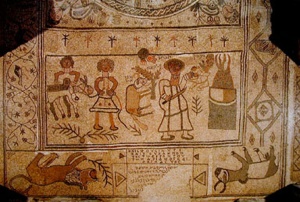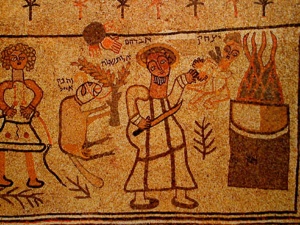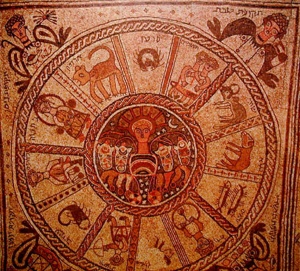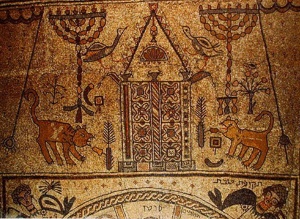Suspended
A figure in the primitive mosaic is depicted suspended in mid-air, seeming to flee his father’s grasp and yet hovering dangerously close to an all consuming fire. It is our forefather Isaac, depicted as a small lad with his hands bound, and in some way; it is all of us.

Our world is wracked with horror, aghast at wanton mass murder as much as by the heartless celebration of our enemies. Whether on the streets of Jerusalem or the streets of New York, we are all suspended between the certainties of normal life before and the moment after terror somehow touched us.
We walk into the ruins of the synagogue at Bet-Alpha in the southern Galilee and wonder what those Jews thought so long ago. Were they suspended too?

The mosaic is now fully covered by a protective shelter, so we must imagine the columns rising up from their bases to support the second story and wooden roof above. The long rectangular floor of the basilica style building stretches before us, the entire surface covered with mosaics. At the far end we see the slightly raised semicircular apse that once contained the Torah niche.
The east aisle is mostly white mosaic while the west aisle is dominated by colorful geometrical patterns. The wide central nave is divided into three sections surrounded by a wide border. We close our eyes and can easily imagine both aisles and the entire center crowded with men, each wrapped in his talis, listening to the Torah as it is read on a temporary desk set in the middle of the hall. It is right over the elaborate mosaic of the zodiac with Helios at its center surrounded by the four seasons. The bal korei is reading the beginning of the twenty-second chapter of Genesis. It is silent. It is Rosh haShanna. The year is early in the sixth century of the common era.

As the men shift their positions during the leining, the women in the balcony above see portions of the floor mosaic nearest the aron appear and disappear beneath the men’s feet.. It depicts another aron, curtains drawn back to reveal a symbolic Temple Aron, surmounted by fantastic birds, flanked by two seven branched Menorahs, a shofar, a lulav, esrog, ash shovel and finally, two primitive lions. It is a vision, perhaps, of the Temple rebuilt.
We can further imagine how the women in the gallery right over the entrance felt as they saw that mosaic floor appear beneath the men’s feet. They knew the scene well and even the artists that had just completed the mosaic. Marianos and his son Ananias were proud of their work and happy that the community leaders had written their names in a mosaic inscription right at the entranceway. This mosaic panel was a straightforward description of the akeidah; Eliezar and Ishmael waiting with the donkey on the left side and the ram tied to the bush with the hand of God appearing out of a symbolic cloud above. The entire right side was strange, unexpected and disturbing. The mosaic depicted Abraham, standing face forward with a long knife at the ready. His hand extends up towards his son, Isaac, who seems to be flying out of his grasp. At the very right edge, just past Isaac, is an altar with a tremendous flame blazing. The women turn to one another and wonder, what can this mean?
What can this image mean for us? Horrible images of bodies flying, momentarily suspended between life and death, are terribly fresh in our memories. The realities of these images frequently end in fire and ashes. How can this be?
Some midrashim on the akeidah tell us that indeed Isaac died on the altar. Either his soul “fled” at the approach of the knife, or some even say he was slain and reduced to ashes. In both cases we are told that the second brocha in the shemoneh esrai of gevorah alludes to the resurrection of Isaac brought back to life in this world with the final blessing; “Blessed are You, Hashem, Who resurrects the dead.”

The artists who created the mosaics at Bet-Alpha in Israel tried to provide us with an answer to what this might mean. To them the prospect of being suspended, hanging between life and death was a given condition of this world. The Temple had been destroyed and hope of its rebuilding was fading with each passing year. Times were difficult and yet the Jews clung to the land. We know that no matter how much we cling to life, God, the True Judge, can act at any time in a manner totally beyond our understanding. If anything, that is the meaning of the next blessing; “You are Holy…” i.e., beyond our grasp. Abraham and Isaac are shown willingly and actively doing God’s will. Isaac is depicted bound since he asked to be bound tightly so that any involuntary flinching would not invalidate the sacrifice or dishonor his father. Our forefather Abraham proceeds and the fire is ready.
As we read the mosaic in the order someone entering the Bet-Alpha synagogue would see it; the akeidah panel is near the entrance. Next the center section is the depiction of the zodiac and the seasons, representing the absolute power of God to order the world, its seasons and the heavenly spheres. Finally, close to where the Torah was kept in the aron at the front, is the symbolic vision of the Temple to come. Most pointedly it is surrounded by the mitzvahs that we must do at this time of year. The shofar, the lulav and esrog, and even the Torah that we must draw near to (encased in the aron) are all shown in the holiest place of the synagogue.
Perhaps seeing these ancient mosaics in this sequence will remind us that even when we feel suspended, we must continue to steadfastly do God’s will. His mitzvot are, in these terrible times, one of the few things that can moor us to life as we mourn the tragedies of our days.